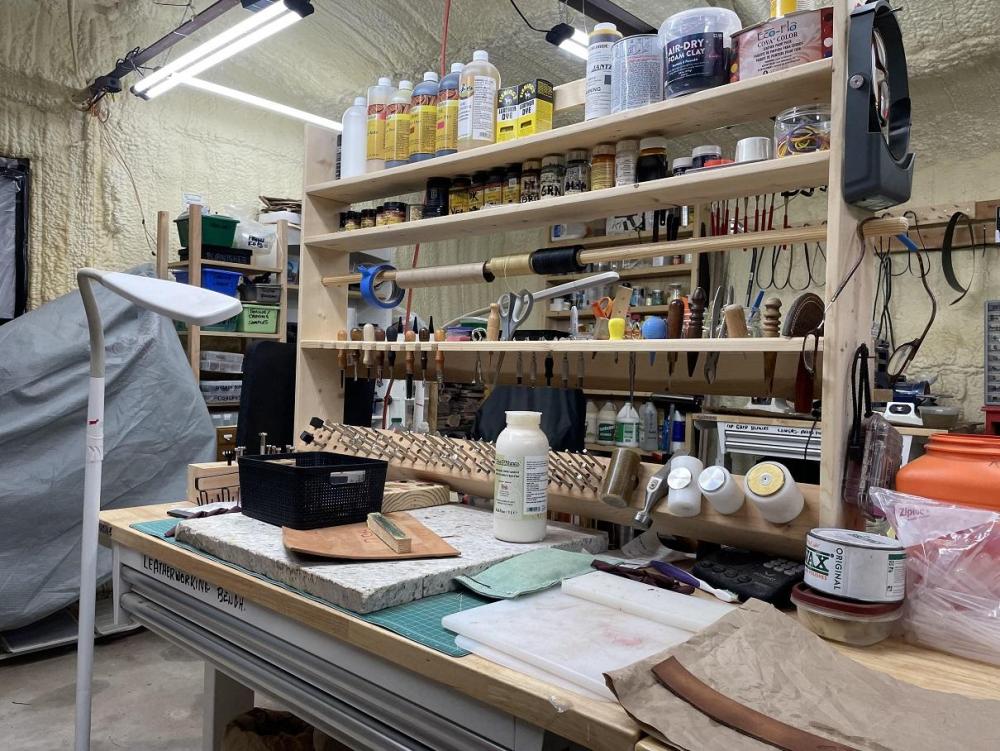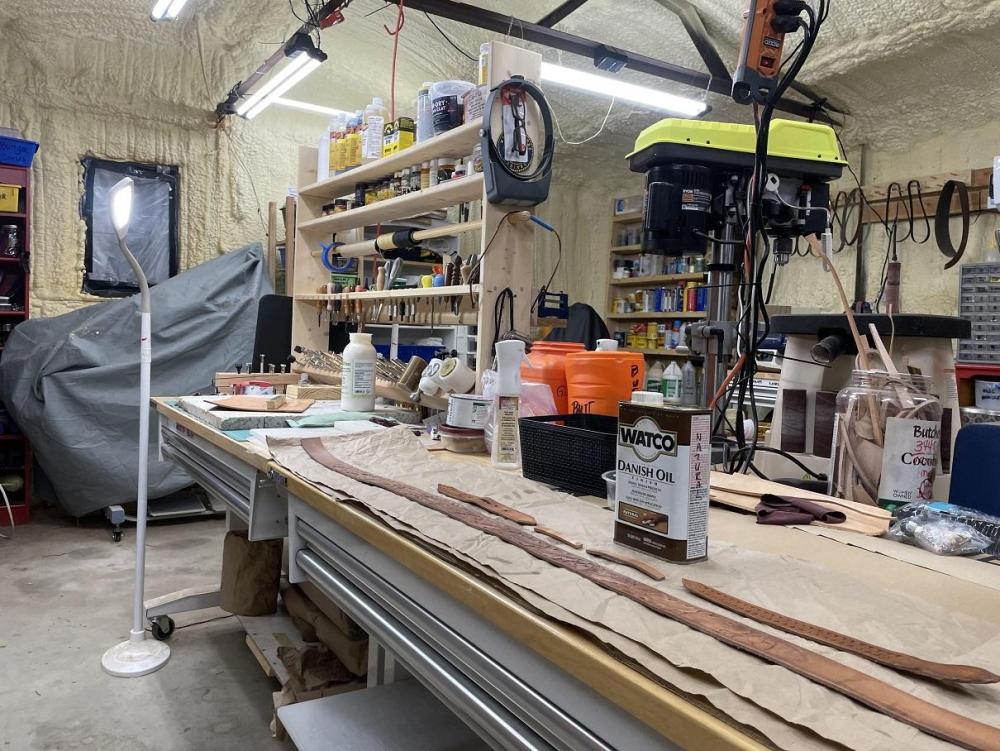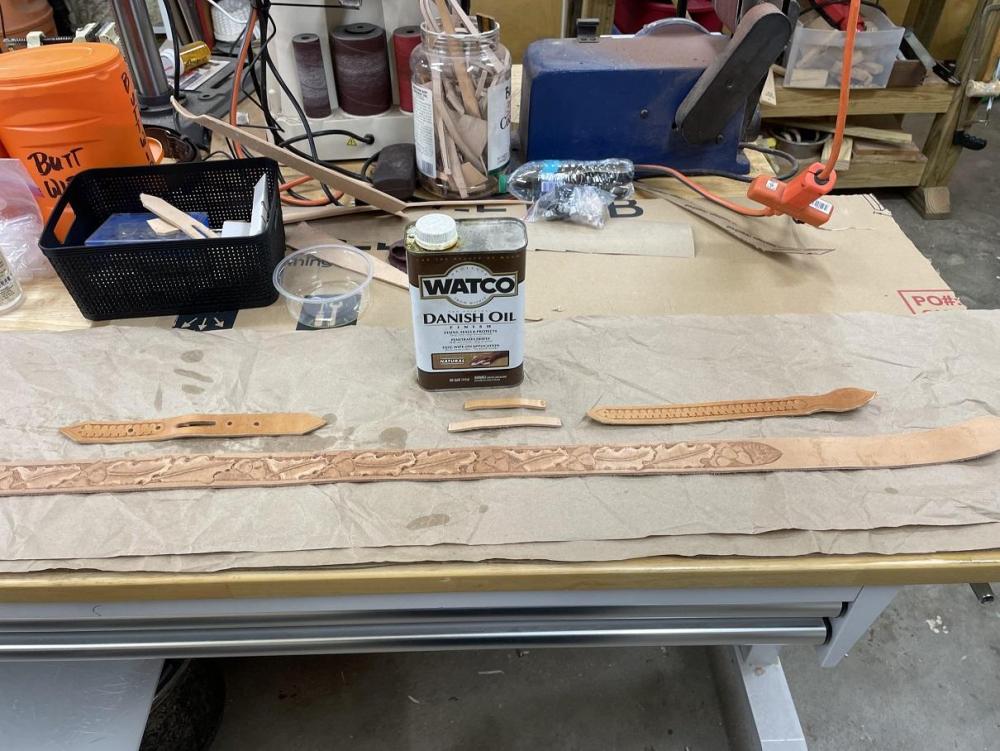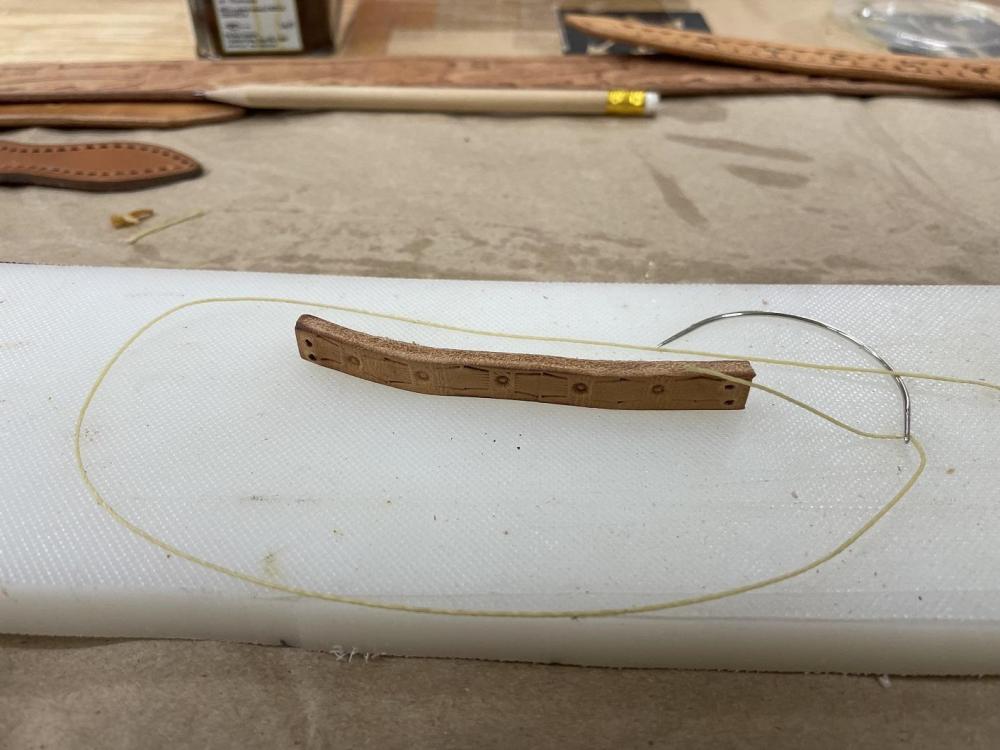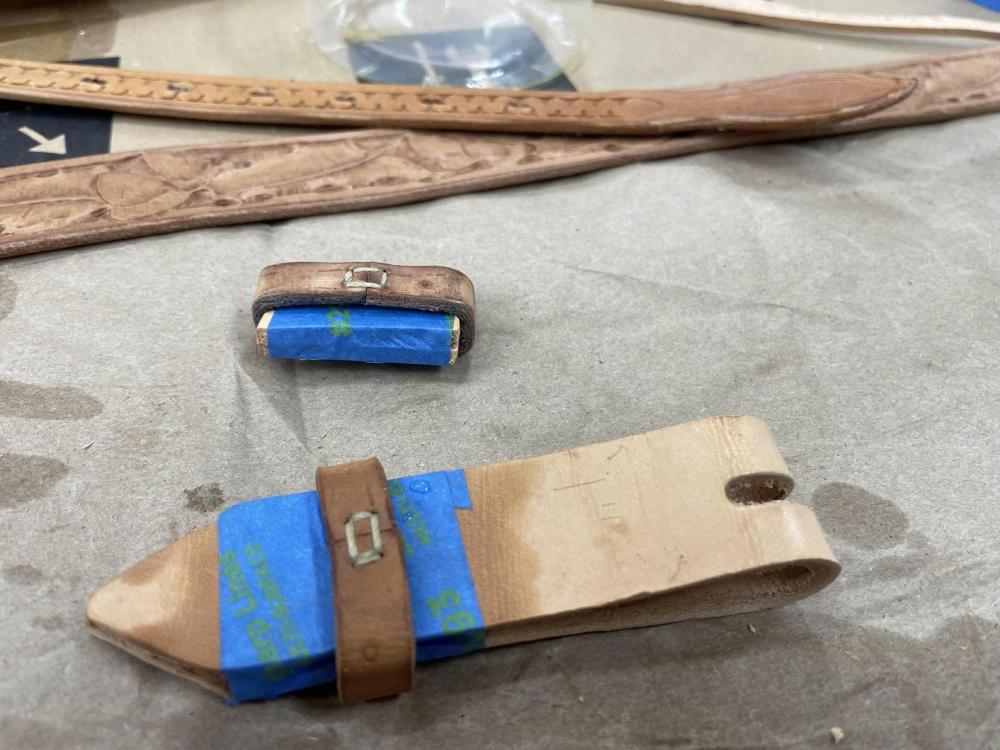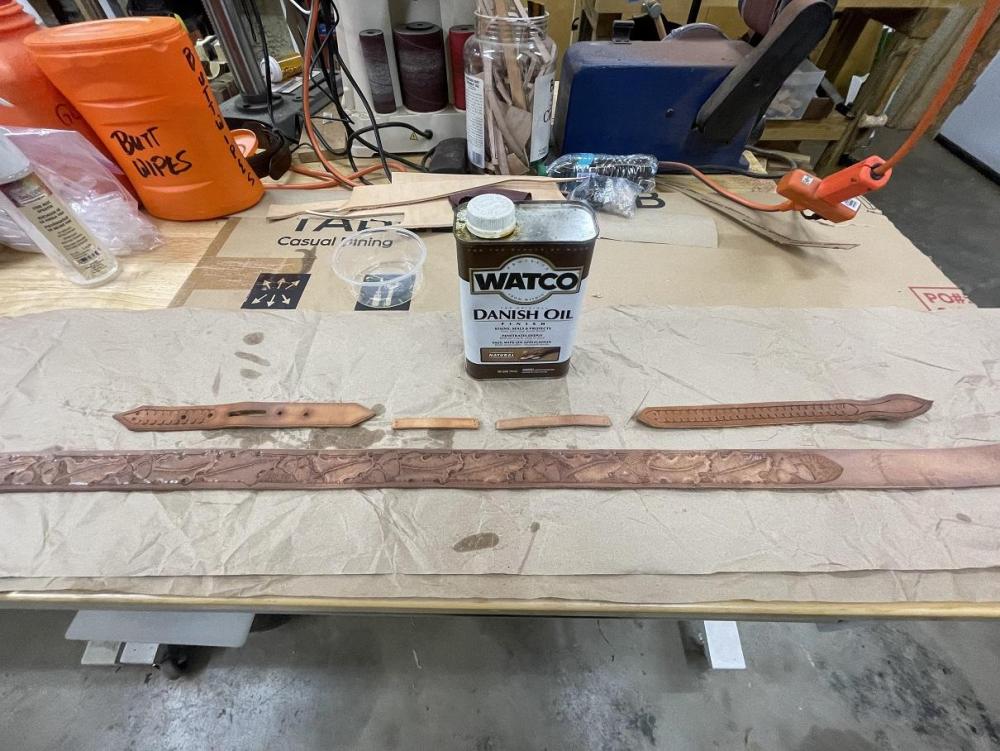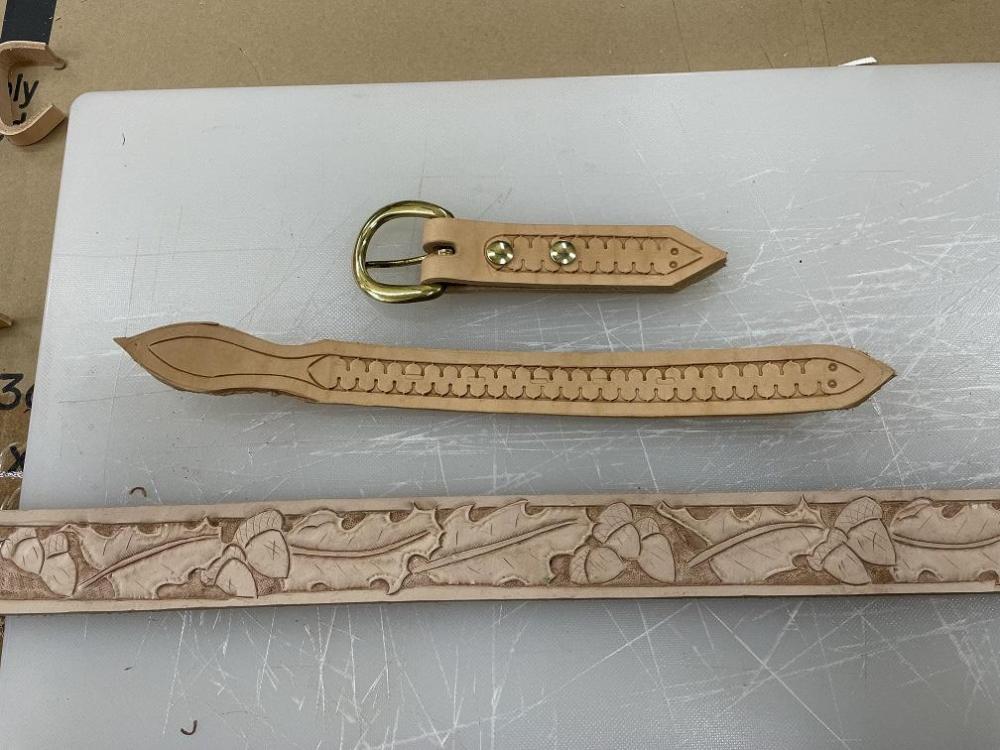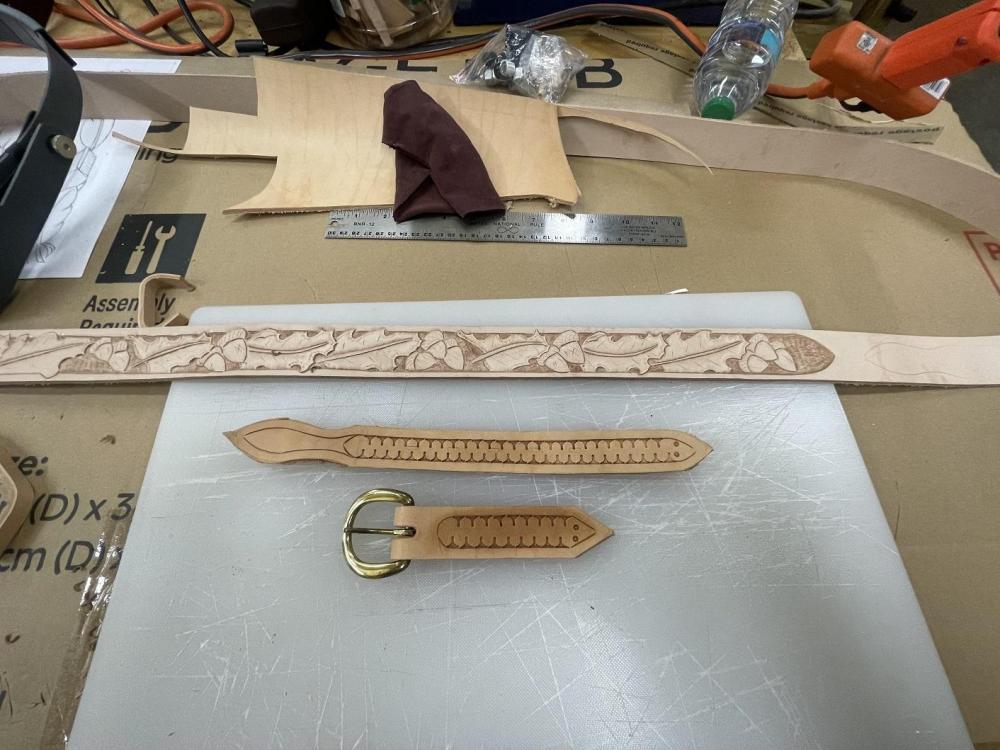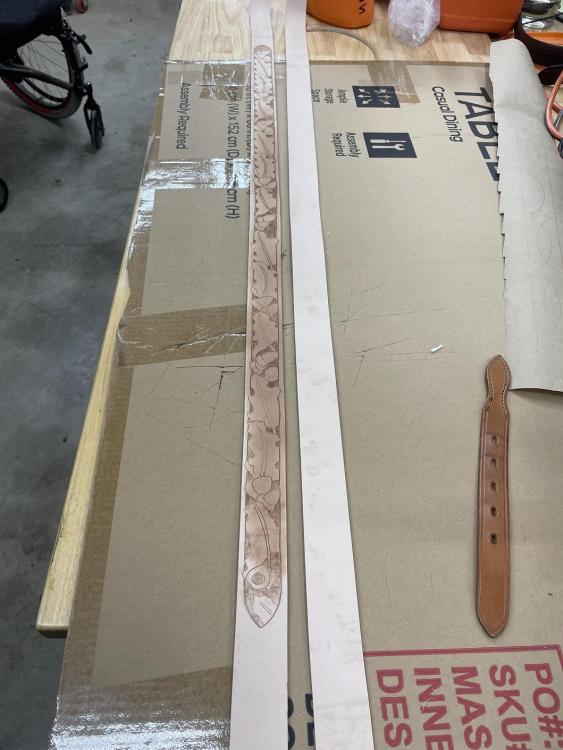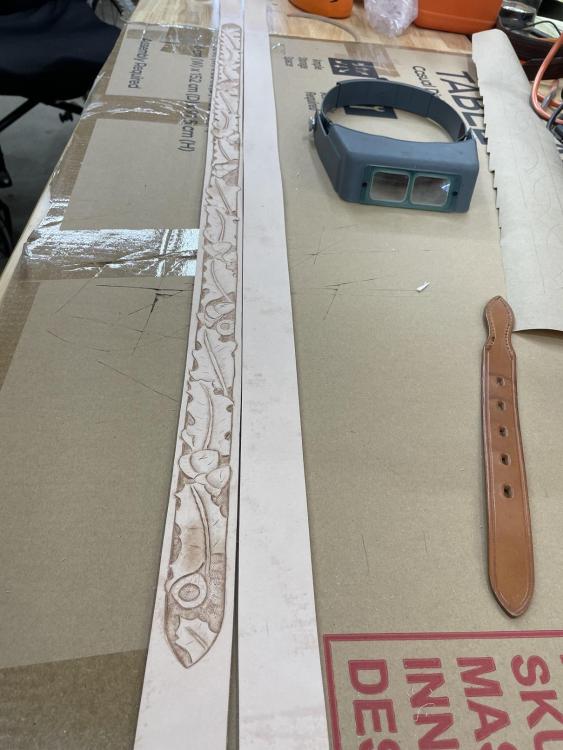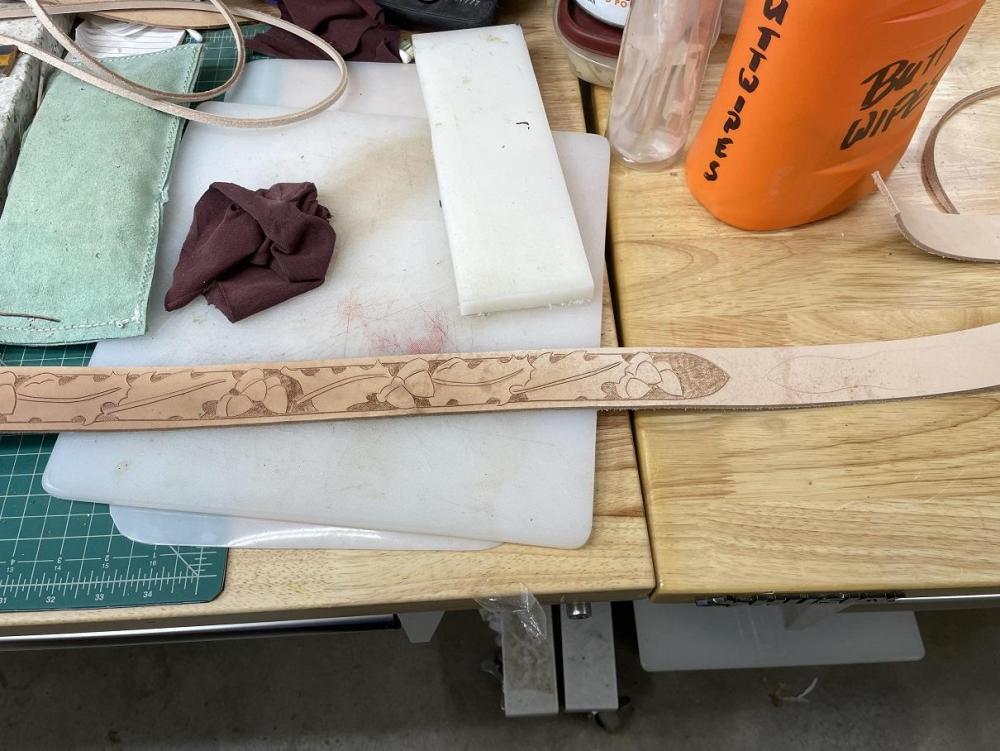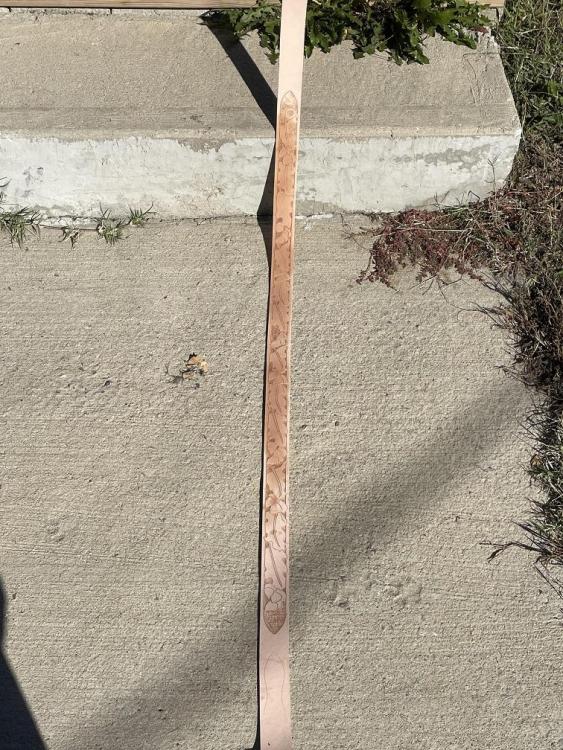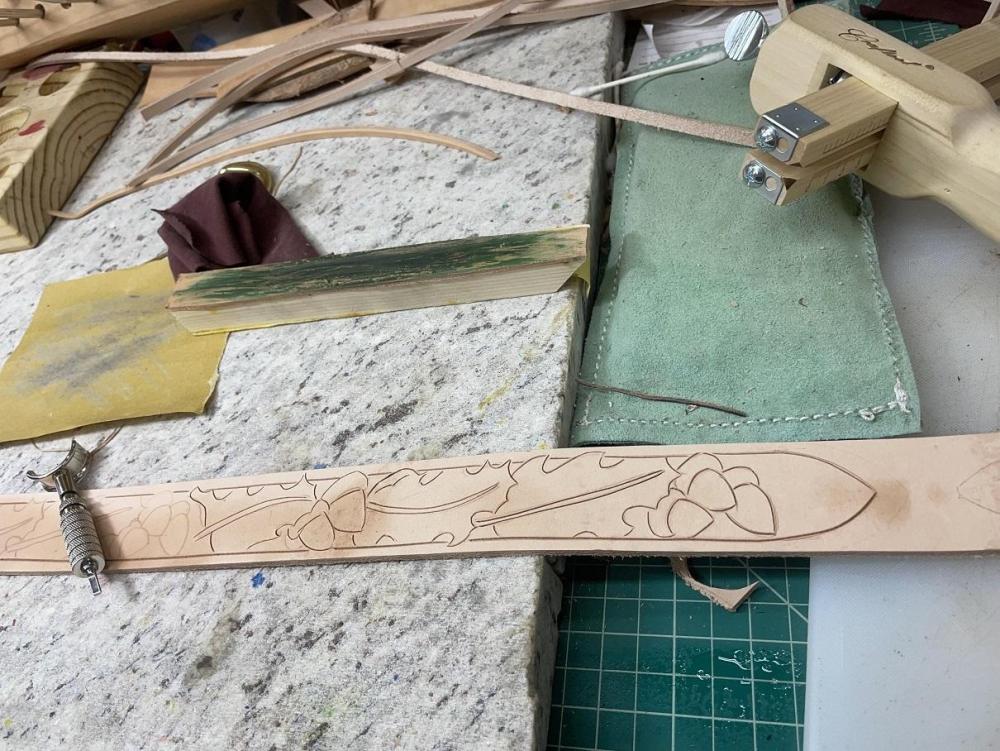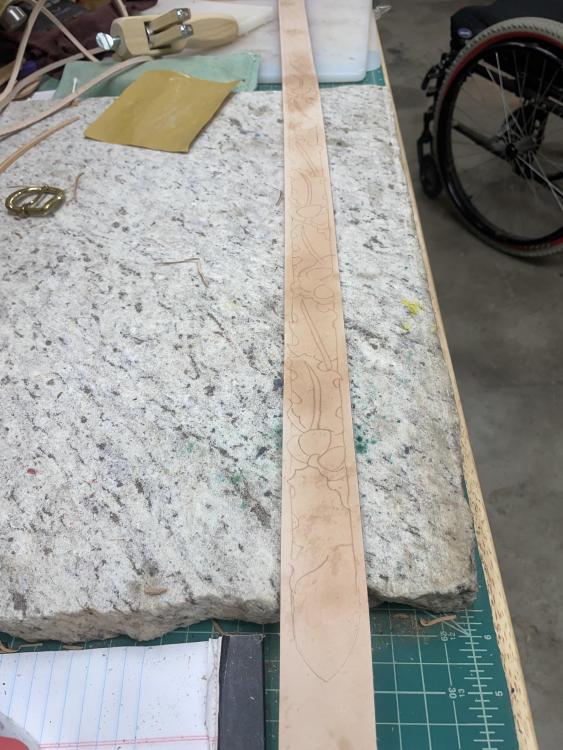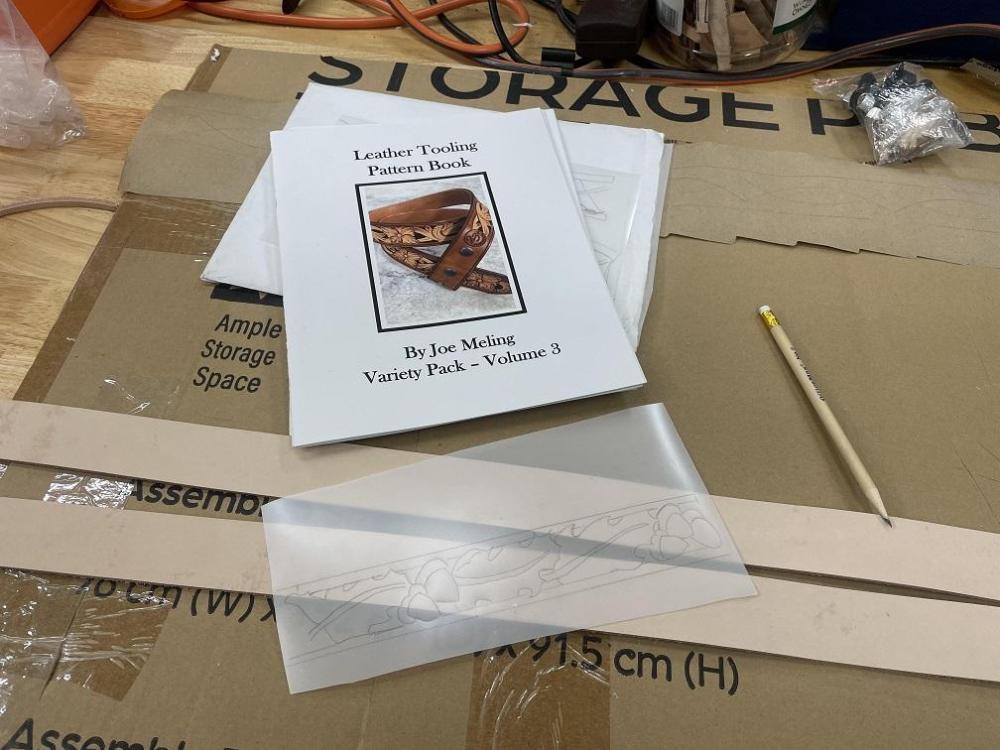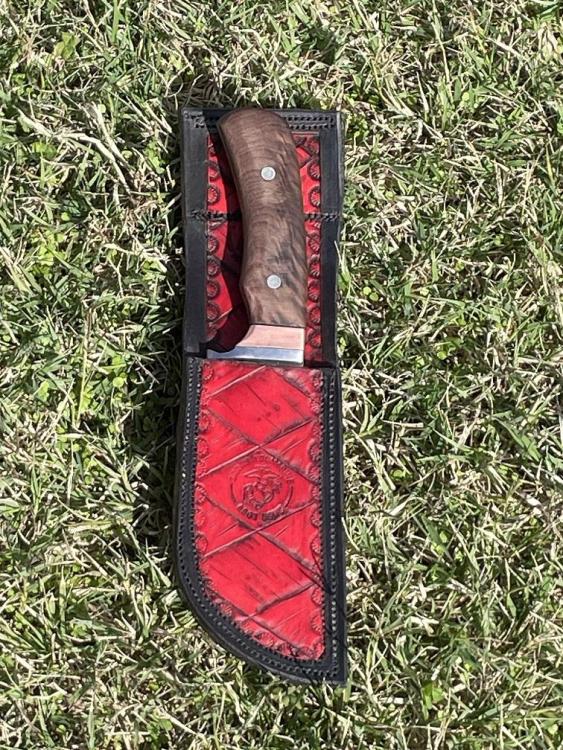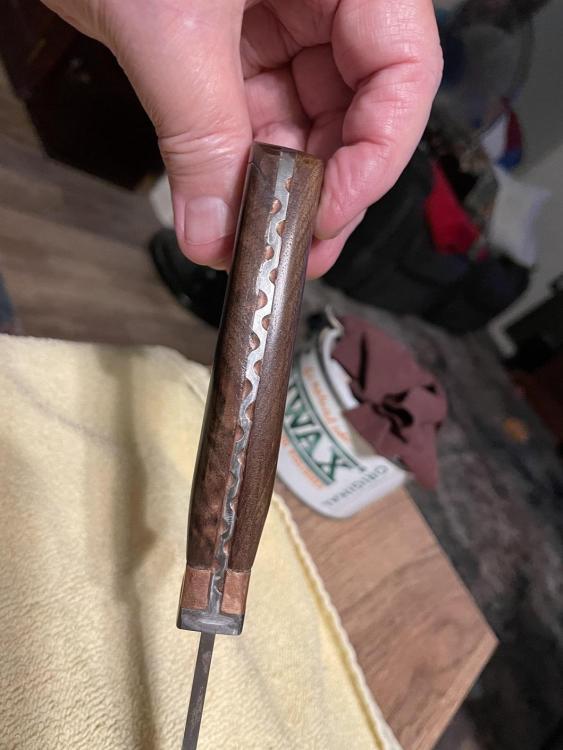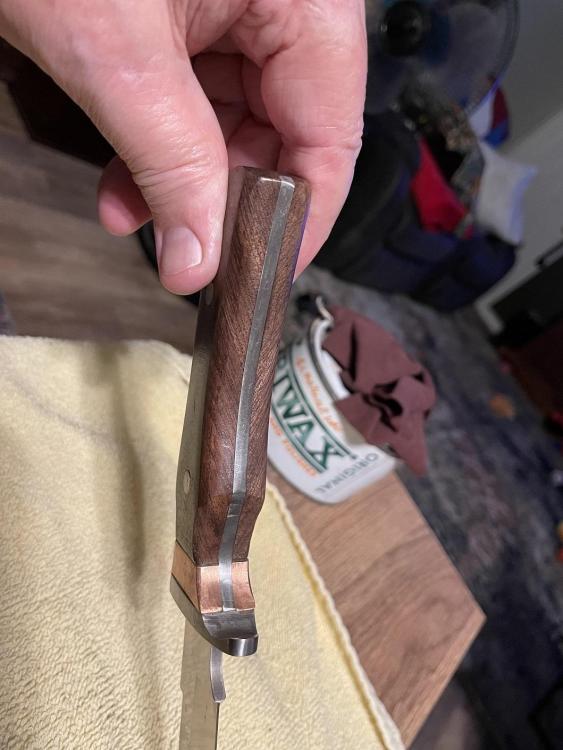-
Posts
573 -
Joined
-
Last visited
Content Type
Profiles
Forums
Events
Blogs
Gallery
Everything posted by Brokenolmarine
-

K frame thumb break
Brokenolmarine replied to Stetson912's topic in Gun Holsters, Rifle Slings and Knife Sheathes
I like it. When I finish the belts I have on my bench, I'm thinking cross draw for my Birdshead Uberti 357 SA. I too like that color, and have used a quilted pattern, but like your extra touches. -
We'll be ready to start assembly soon, sewing on the billets. But, how about a mini-tour of the leather work station? Start here, at the tooling bench. I started with just the tool block at the back of the table, to keep the punches organized, then added the shelving to keep the tools out of drawers and more at hand. Oh, yeah. There are still things in the drawers, but most things are at hand. (Yes, I know I need to refill the paper towels, I just ran out.) If we back up a bit, you'll be able to see my cutting / work table. That is beside the tooling bench, and I try and keep it as clear as I can. It's nice to have it there, as I can roll back and forth between stations. Very handy on projects like holsters and sheaths when you need to trim or add pieces. If I am not on this side of the four bench set up. I'm usually on the knife side.
-
Out this morning to check the look of the belt parts now that the oil had dried. I am very happy with the color. So, first step was to mark and cut out the oval holes in the billet that would accept the buckle. I used the correct size bit to drill a hole in each end of the ovals and cut along the sides with a scapel to connect the two holes. Once that was done I was ready to burnish. I used a thin burnishing wheel in the drill press. A wise lesson learned was that FRICTION not pressure is the key here. Pressure will deform the pieces and friction generates the heat you need. Allow the time and the light pressure will cause the friction to generate the heat, without deforming the pieces. I took my time, and knocked out all the pieces. Then it was time to form the belt loops. I drilled a pair of pilot holes in both ends of each loop, then sized them with the sewing awl. I waxed the thread, taped the mock ups from scrap leather for the wet forming and got busy. After careful sewing with a curved needle, I was ready to wet form them around the mockups and burnish them square.
-
THIS is a great idea, but my copier is OLD and needs to be disassembled and cleaned internally. It leaves spotches and smears on the copies and scans, something somewhere internally. So, I just ignore them when I trace. I guess I could buy another package of transparency film. I had a box at one point when I was teaching in the academy, but once I quit Miss Tina started using them all the time for our overhead projector to paint things on the walls. NO more left and she gave the overhead to the daughter. LOL.
-
If I was going to put a backing on the belt I would, but in this case I'm not going to do that so I didn't allow spacing for it. If I had planned to sew down the side I would have allowed extra border for it.
-
After some last trimming where needed and some sanding, I beveled the edges as appropriate, then applied coats of Watco Oil in the Natural color. I'll leave the parts and pieces to dry overnight and find out what they look like in the morning. Once they are dry, I can burnish those edges and get busy. I'll form the two belt loops and can begin the assembly process, sewing on the billets after determining the best location. We'll either have a belt or a nice sample practice piece. I'm REALLY hoping for a belt, tired of my pants slipping down.
-
Nice work, if I still lived in Tampa, I'd bid it up. I went to Hillsborough High a LONG time ago.
-
Got the holes drilled for the Chicago Screws... and we are looking good. Need to get out and burnish the sides. Then I can move forward with applying the finishes. I'm leaning toward a natural finish for the belt.
-
Thanks, as Johnny Carson would say, "I did not know that."
-
Billets? That's what they are called.
-
Back out this afternoon after Miss T got home with lunch. I spent some time on the belt working on the details, then worked on the buckle attachment and the strap that will have the holes in it. I'm sure those parts have names... but I don't know them. (Yet.) After I cut them out... I (Of course) had to add some details. I went with the serpentine pattern since the straps were too narrow for much else. When I do the cartridge belt, I think I'll go with a barbed wire pattern. (Ever notice some folks think the wire was named after a guy named Bob?) Usually it's folks who have never strung it, repaired it, or tried to get through it in a hurry (Being chased by an angry bull or an angry farmer, and met "Barbs". We are so close. I have to drill / punch holes for the buckle attachment chicago screws, and the holes where the buckle bar will go in that strap. I need to burnish ALL the edges after I have decided on stain, or natural oil... then after everything has had it's first coat, sew it all together. I also need to make two retention loops. One for the belt to slide into, then one for the buckle strap to slide into. All fun. Still, close.
-
The pattern in the video is a bit different, but the techniques still apply.
-
-
The good thing is, many of the patterns you can find a video of him using that pattern to tool IN a video. The oak leaves and acorns he tools and narrates an excellent HOW TO as he does it. It was done live so he is interacting with the comments from those watching. I really loved watching it and it's why I ordered the books.
-
The books are heavy paper, with the drawings for the patterns progressing from very basic lines, to more detail, to a finished tooled picture. There are no mylar patterns, I have a roll of the tracing stuff I use to copy the pattern. Sometimes I copy the pattern on my copier then use my backlit tracing screen to make it really easy. Thanks, me too. I have the basic idea of how I want to have the finished belt to look, but ... like many of my projects, I'm winging it here. I live dangerously. Believe it or not, I have never made a belt.
-
See that Strap off to the side? That came off a Gunfighter Cartridge Belt from a big name I had years ago when I started to shoot IPSC. (Started to shoot, didn't do well.) I was young and didn't have the funds for a lot of practice. I think it would have been in the Late 70s / Early 80s. It was a Bianchi piece of gear, VERY nice. I held on to it for years, DREAMING I might one day get back into it. Yeah, never happen. I finally dismantled the belt and saved certain parts for templates. I have used them often here and there. I "recycle." Thanks. I'm hoping for a good result. If not, great practice. I keep a positive outlook. (I do say nasty things in the shop when I blow it, but there isn't anyone to hear.)
-
Using a steep bevel, I worked on the features, sharpening the edges of each one and beginning to define them and highlighting. Beginning the 3D effects. During a second session, I really worked hard on the effects, working to push the illusion of items diving under the edge or protruding over the edge. I had also put more detail into the leaves and acorns, but there is still more to do. In the next session, I'll work on pear shading leaves, lifting, and edge details in the leaves. All items I have had some success with, but also some dismal failures. Wish me luck.
-
MY next step is shading in the background. It helps me to define the areas and to know what is what. This pattern especially has features that are drawn to appear to go over or under the tooling window edges. I took two sessions to background the piece but it really made a huge difference. The long view gives you a feel for how it makes the design POP. Once the hands get a break, I can start beveling the edges of the features and then work on details.
-
With arthritis, you can only do so much and then you have to take your breaks. I got this far, then took a lunch break. I came back after lunch to finish cutting in.
-
Using that pattern, I determined the length I needed at the ends for the buckle attachment and the attachment of the strap with the holes, then lightly drew in the defined end of the tooling window. Then I could start working the pattern from one end to the other. After I transferred the pattern, I sharpened two of my swivel knives, buffed them out on the rouged leather strope, and got busy cutting in. Fatter blade for the edge, and nice thin blade for the details.
-
Oh, Wait, that would be me. I need to work on my tooling and carving, so I decided what better way to practice than to tool a belt. My biggest problem is I don't have a butt. I have a gut, but no butt, so my pants are always trying to fall off. That can be somewhat embarrassing. Well, you know, depending on where you are. If I'm walking the dog in the middle of the north pasture, no one cares. We even got rid of the cows. They used to give me funny looks if my pants fell down, but even they are gone... so it's no longer an issue there. But, if I'm going down an aisle in Home Depot, that might be a different story. That's why I wear big ol' Suspenders. So, to get started, I cut out a couple wide strips of nice heavy leather. Nice looking stuff that should tool well. I'll carve the first belt, and get in that practice, then the second I'll put some bullet loops on for the 38/357; and use it for walks thru the woods or on my range.... at least that's the plan.
-
It's red. I just apply additional coats until I get about the color I want, keeping in mind I'll antique it, then apply the mink oil and wax, so it will darken.
-
The sheath was a practice piece to let me work with the Cowboy 3200. I still am learning the machine and it can do a lot more than I can right now. The wife is a quilter and can sew like a demon on my machine, but SHE has about six machines in her shop. Phaffs and Berninas, and several other top names. I'm "Learning" my machine and getting better. I finished the sheath in beeswax as well. This might be a keeper.
-
The knife is a Highly Figured Walnut Skinner. I didn't forge the blade blank, that came from my supplier, Jantz Knife in Davis, Oklahoma. They have everything I need to make them. The walnut came from my stash I have had for years. I formed the copper accent from 1" wide, 3/8" thick bar stock. The pins are Nickle Silver from round stock. I enjoy pushing my skills to strive for improvement and learn most of the skills from YouTube videos. The tooling on the spine is improving. I bought some metallic tint powder and tinted the epoxy to accent the tooling. First time I've tried that ... The highly figured walnut scales came out beautifully. I shaped them on the 1x30 belt sander then finish sanded them by hand to 1,000 grit. I love to bring them to life. I used Watco Golden Oak Oil Stain to make that grain pop with seven coats of Beeswax to finish and protect.
-
I like the knife and the sheath. Both are very well done.



